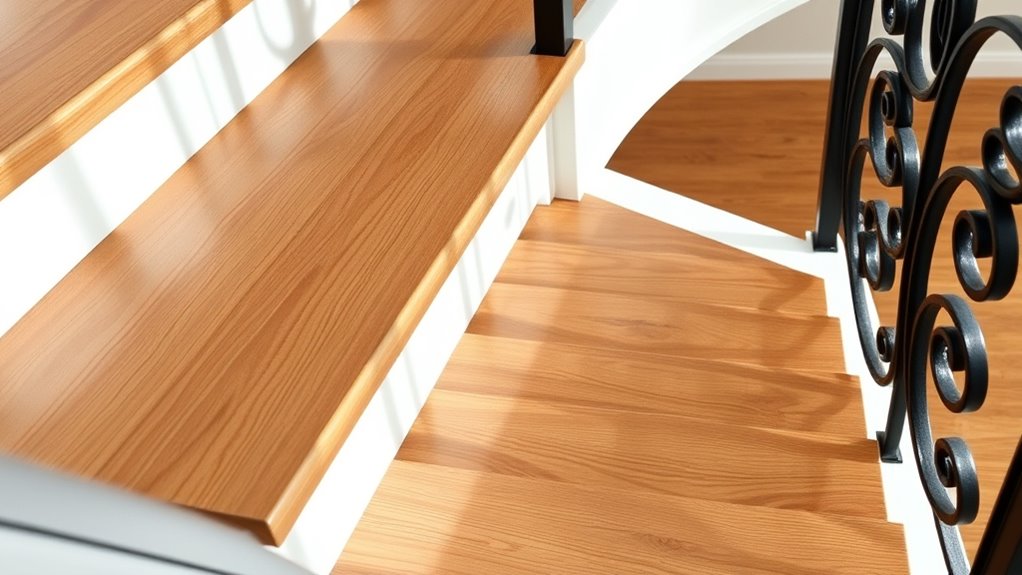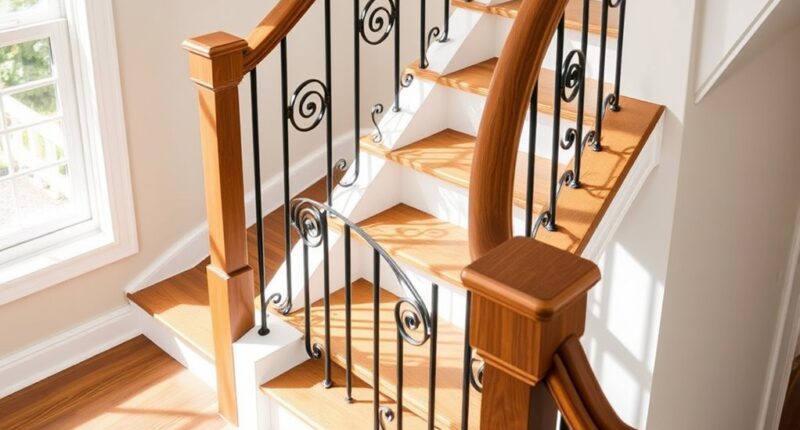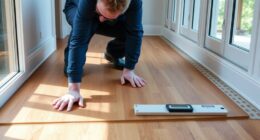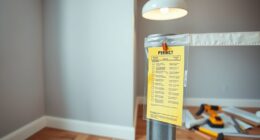To upgrade your staircase, focus on selecting durable materials like hardwood, engineered wood, or reinforced concrete for treads that meet safety standards with appropriate depth, width, and non-slip surfaces. For risers, make certain uniform height, secure attachment, and weather-resistant finishes using materials such as veneer plywood or glass. For rails, choose strong materials like stainless steel or tempered glass with ergonomic designs and safe spacing. Attention to precise measurements and compliance enhances both safety and style—exploring these details reveals how to optimize your staircase’s performance and look.
Key Takeaways
- Select durable materials like hardwood or reinforced concrete for treads to withstand foot traffic and prevent slips.
- Ensure risers are consistent in height and securely attached, using materials like veneer plywood or metal for safety and aesthetics.
- Choose railing materials such as stainless steel, wrought iron, or glass, and design for ergonomic grip and compliance with safety standards.
- Upgrade tread depth and add non-slip treatments to reduce slip hazards, while maintaining proper riser heights to prevent tripping.
- Incorporate modern design elements like lighting or minimalist profiles to enhance appearance without compromising safety and stability.

Have you considered how upgrading your staircase can notably enhance both safety and aesthetics? When focusing on treads, risers, and rails, each component plays a critical role in the overall functionality and visual appeal of your staircase. Precise selection and installation are essential to guarantee compliance with safety standards and to achieve a sleek, modern appearance.
Starting with treads, these horizontal surfaces must withstand significant foot traffic and weight. Upgrading to high-quality materials such as hardwood, engineered wood, or reinforced concrete improves durability and reduces wear over time. For safety, you should consider increasing the depth and width of your treads to meet local building codes, which typically specify minimum dimensions to prevent slips and falls. Non-slip treatments or textured surfaces can further enhance traction, especially in environments prone to moisture or dust. Proper thickness is equally important: thicker treads provide stability and reduce bounce, contributing to a solid footing. Precision in measurement and installation ensures that each tread aligns perfectly with the riser, maintaining uniformity and preventing tripping hazards.
Risers, the vertical components between treads, serve both structural and aesthetic purposes. Upgrading risers involves selecting materials that complement the treads while providing sufficient strength to bear vertical loads. Materials such as plywood with veneer overlays, metal panels, or even glass can be used, depending on your design goals. Guaranteeing consistent height and secure attachment is vital; irregular riser heights can cause tripping and compromise safety. Additionally, proper finishing of risers—whether through painting, staining, or sealing—prevents moisture intrusion and extends longevity. If you’re aiming for a minimalist or contemporary look, consider thin, sleek risers, but never at the expense of structural integrity or code compliance.
The staircase railing system is integral to safety and style. Upgrading rails involves selecting materials like stainless steel, wrought iron, or tempered glass, each offering different aesthetic and functional qualities. The handrail must be comfortably graspable, with diameter and shape adhering to ergonomic standards. Mounting height and spacing between balusters are regulated to prevent accidental falls, especially in homes with children or elderly residents. Precise anchoring to the staircase structure ensures stability under load. Modern designs often incorporate integrated lighting or minimalistic profiles, but these should not compromise strength or safety. Regular inspection and maintenance of the railing system are necessary to identify and address potential weaknesses, such as loose fittings or corrosion.
Frequently Asked Questions
What Are the Best Materials for Durable Staircase Upgrades?
You should choose hardwoods like oak, maple, or hickory for durable staircase upgrades, as they resist wear and provide structural stability. Metal options such as stainless steel or wrought iron offer high strength and longevity, especially for rails. Composite materials, including vinyl or fiberglass, are also resilient and low-maintenance. Prioritize materials that combine strength, ease of maintenance, and aesthetic appeal to guarantee your staircase remains safe and attractive over time.
How Do I Match New Staircase Elements With Existing Decor?
Think of your staircase as a visual bridge—matching new elements with existing decor creates harmony. To achieve this, analyze your current color palette and material finishes. Opt for complementary tones, such as matching wood stains or coordinating metal finishes. Consider style consistency—modern, traditional, or rustic—to guarantee cohesion. Use samples and mock-ups to preview how new treads, risers, or rails blend seamlessly, enhancing your home’s aesthetic without disrupting its design flow.
What Permits Are Required for Staircase Renovations?
You need to check local building codes and obtain necessary permits before renovating your staircase. Contact your city or county building department to determine specific requirements, which may include submitting detailed plans, inspections, and compliance with safety standards. Failing to secure permits can result in fines or delays. Make certain you follow all regulations to guarantee your renovation is legal, safe, and up to code.
How Long Does a Typical Staircase Upgrade Take?
Time flies when you’re upgrading a staircase, but typically, it takes about 3 to 7 days. You can expect a faster process if the scope is limited to replacing treads and risers, while more extensive work like installing new rails or structural modifications may extend the timeline. Planning and efficient execution are key; remember, “time and tide wait for no man,” so schedule accordingly to minimize disruption.
Are There Ergonomic Considerations for Safer Stairs?
You should prioritize ergonomic considerations for safer stairs by ensuring ideal tread depth (at least 10 inches) and riser height (around 7 inches) to reduce tripping hazards. Incorporate handrails at appropriate heights for stability and use non-slip surfaces to improve traction. Proper lighting and clear headroom are essential. These measures collectively enhance safety, comfort, and accessibility, minimizing fall risk and accommodating users with varying mobility levels.
Conclusion
Upgrading your staircase transforms it into the backbone of your space, blending form and function seamlessly. By selecting the right treads, risers, and rails, you guarantee durability and safety while elevating aesthetic appeal. Think of your staircase as the spine of your home—strengthening its core enhances the entire structure. With careful attention to detail and quality materials, your upgrade becomes a precise art, creating a lasting impression that supports your lifestyle for years to come.









